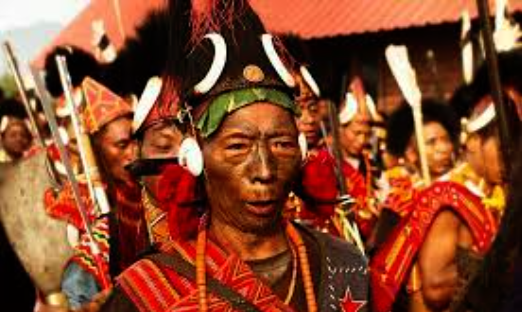Tribe: Naga
The Nagas, a group of indigenous tribes in northeast India, reside in the mountainous region of Nagaland. They have a total population of about three million belonging to around sixteen tribes. They are known for their strong sense of independence and warrior culture. With unique languages, music, dance, and art, the Nagas have a rich and diverse culture derived from both their long history and heritage and residual Christian influences from British rule. Their wear distinct and vibrant attire, featuring tribal jewelry inspired by their warrior roots. While Christianity has influenced their music and arts, the Nagas have elegantly integrated these elements into their indigenous culture.

Location
The Naga tribes are primarily located in the Nagaland, a remote northeastern state of India. Nagaland is surrounded by the states of Assam, Arunachal Pradesh, and Manipur, as well as the country of Myanmar. The Naga people can also be find in these neighboring areas. This region’s rugged terrain has played a shaped the tribe’s resilience, culture, and identity.

History
The Nagas are of Tibetan-Chinese heritage. It is believed that their ancestors arrived in India from around the Yangtze river in China to settle in the foothills of the Himalayas. They arrived in several waves of migrations that took place over centuries. In the late 19th century, the British began to expand their influence in the region, leading to conflicts with the Naga people who fiercely resisted their rule. Despite multiple attempts, the British were never able to fully subdue the Nagas. After India gained independence from the British, the Nagas demanded the establishment of an independent state. In 1963, Nagaland was established as a separate state within the Indian union.

Culture
While the Nagas speak many languages, English is predominant.
The majority of the tribes live in the mountains in single story bamboo houses with thatched roofs.
The Nagas are bound by a strong sense of community. True to their warrior roots, their children are taught the art of warfare at an early age.
Traditionally Naga music has a strong Western influence. They use a variety of instruments including drums, flutes, and gongs. Naga folk songs often tell stories of love, war, and the relationship between humans and nature. The Naga tribes also have a rich tradition of dance with each tribe having their own style.
The Naga tribes are known for their colorful traditional clothing, which features intricate patterns and designs.
They are also known for their traditional agricultural practices, including terrace farming and shifting cultivation.
The Hornbill festival, which is named after a bird common in Nagaland, is the most important festival of the Naga tribes. It is a festival where many tribes come together and showcase their traditional music and dances. They also show off their hunting and warring skills.
The Nagas have a distinct cuisine featuring a variety of meats and fishes. A common dish is made from the head of a pig. They also make delicious chutneys from bamboo shoots.

